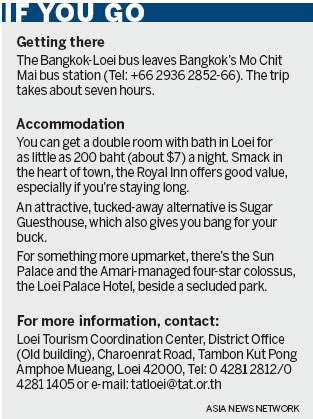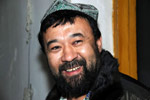Tips and Articles
Thai surprises
Updated: 2011-02-08 07:36
By David Wilson (China Daily)
|
Clockwise from the top: Tat Hong waterfall, mountains around Loei, and the pi-ta-khon festival in Loei. Photos provided to China Daily |
This village is a little hard to reach, but it's worth the journey, as David Wilson reports
The remoteness of the northeastern Thai town of Loei is reflected in the name itself: Loei (pronounced "loy") in Thai means "beyond" or "farthest extreme", and it certainly seems like that. If you make your way up here, you'll likely find that although Thais come to this town of just 30,000 people in droves, very few foreign visitors do.True, apart from the two establishments near Loei Lifelong Learning Plaza, the town lacks enticing cafes and restaurants. Still, Loei's status as a backwater, which is reflected in one travel bible's verdict, seems unwarranted.
It has tons of charm: friendly people (even the tuk-tuk drivers are nice) and a lovely landscape. Better yet, laid-back Loei, which lies near the border with Laos, is a breeze to reach. You just hop on a sleep-friendly VIP bus from Bangkok for a seven-hour ride.
In sharp contrast to the Thai capital, Loei reeks of countryside - or rather of marigolds, which are liberally drizzled over verges and roundabouts. On the rooftops, swarms of starlings scream.
And, bobbing at the surface of the Mekong tributary that winds through town, catfish pucker up for edible pellets that are sold alongside the bridge.
Cross the bridge and you enter Kut Pong Park, the scene of a cotton blossom festival in February. On sunny days, Kut Pong - a sort of jungle peppered with fir trees - has an empty look since it is visited by just a few students, who lounge around the pavilions, watching people and texting.
But, at dusk the light assumes a cool silver tone and droves of locals enter the picture. Some jog around the park's perimeter, others grapple with the Stone-Age-style exercise apparatus. Still others do some synchronized dancing or play sepak takraw. The bustle conveys Loei's aura of health and harmony.
While the town borders on the tame, it does have its wild side. Take a peek at its signature club, the coolly named hard-core, high-tech Robot 2029. It's a gathering place for local rock and hip hop acts, scantily clad "coyote" dancers, and it attracts the 20-something set.
It squats at the end of a dauntingly long forecourt, at either end of which stand eerie sci-fi statues. These space-age guardians are as striking as the podium dancers writhing inside, and make great photo fodder.
They also raise the specter of a traditional Loei attraction: the ghosts and monsters that run amok, dragging bells in their wake, during the Pi-Ta-Khon festival.
This festival is held on the first day of a three-day Buddhist merit-making holiday (Boon Pra Wate), usually in June, at Dan Sai, two hours west of Loei. Pi-Ta-Khon is crazy. It resembles Mexico's Day of The Dead, only with a Buddhist flavor and lurid overtones.
The dancers' masks are made of sticky rice husks and have long wiggly noses and fangs. This grotesque image appears everywhere - from lampshades to Robot designs to the Loei City FC's insignia. The prancing, masked revelers look weirder still because they wield massive phallic clubs that symbolize fertility.
These weapons are supposed to get the sky god, Phaya Thaen, to anoint the region with rain. The reason the revelers wave them around is simple: Once upon a time, the sky god, stung by Buddha's popularity, withheld rain for seven years and seven months and seven days.
This, presumably, worked up quite a thirst in the locals.
 |
During the "winter", from November to February, the air is moist, even icy, thanks to the mist rolling in from the mountain ranges that loosely frame Loei. They increase its near mystical feel of isolation.
The most spectacular of all these mountains may well be Kradung, which is Thai for "bell". It is laced with a myriad of trails that lead you through forests of pine, oak and beech. If you're lucky, you might get a glimpse of some big-ticket wildlife like jackals, deer, gibbons, bears, elephants, or even tigers.
If you only encounter a toad or two, you can always inject some drama into your hike by heading to the bell-shaped, sandstone mountain peak. If you're fit, you can finish the hike in three hours. If you want to cheat, there are ladders and stairs lacing the route, which help.
You just might want to loaf around in the shade of a waterfall. There are many in the area. The one that makes the most splash - 40-meter-high, thunderous Tat Hong - has an overhang shaped like a junk's prow. But be careful about trying for a full-throttle view of the torrent by getting too close to the edge.
A jungle trail there follows the route that members of a freedom movement in World War II used to trek south to the ancient city of Phetchabun, dodging marauding Japanese forces along the way. The jungle trail also goes past prehistoric cave paintings.
When you add in all the other possible detours, including a winery that makes Chateau de Loei, a Kunming-style rock garden, and a reservoir for boating, Loei starts looking like one of interior Thailand's most enticing resorts, every bit as seductive as leafy Kanchanaburi.
But, Loei also offers a distinctive culinary mix of piquant Isan eateries and Bavarian cake shops.
In fact, it is a reasonably believable version of paradise.
Just watch out for the dogs downtown that turn cranky at night. And think twice about going at April's summery height, when the bewitching mists evaporate and the remote outpost shows its other side - the hottest place in Thailand.
Specials

Spring Festival
The Spring Festival is the most important traditional festival for family reunions.

Top 10
A summary of the major events both inside and outside China.

A role model
Alimjan Halik had been selected as the "Cyberspace Personality Who Moved the Hearts of the Chinese in 2010".
